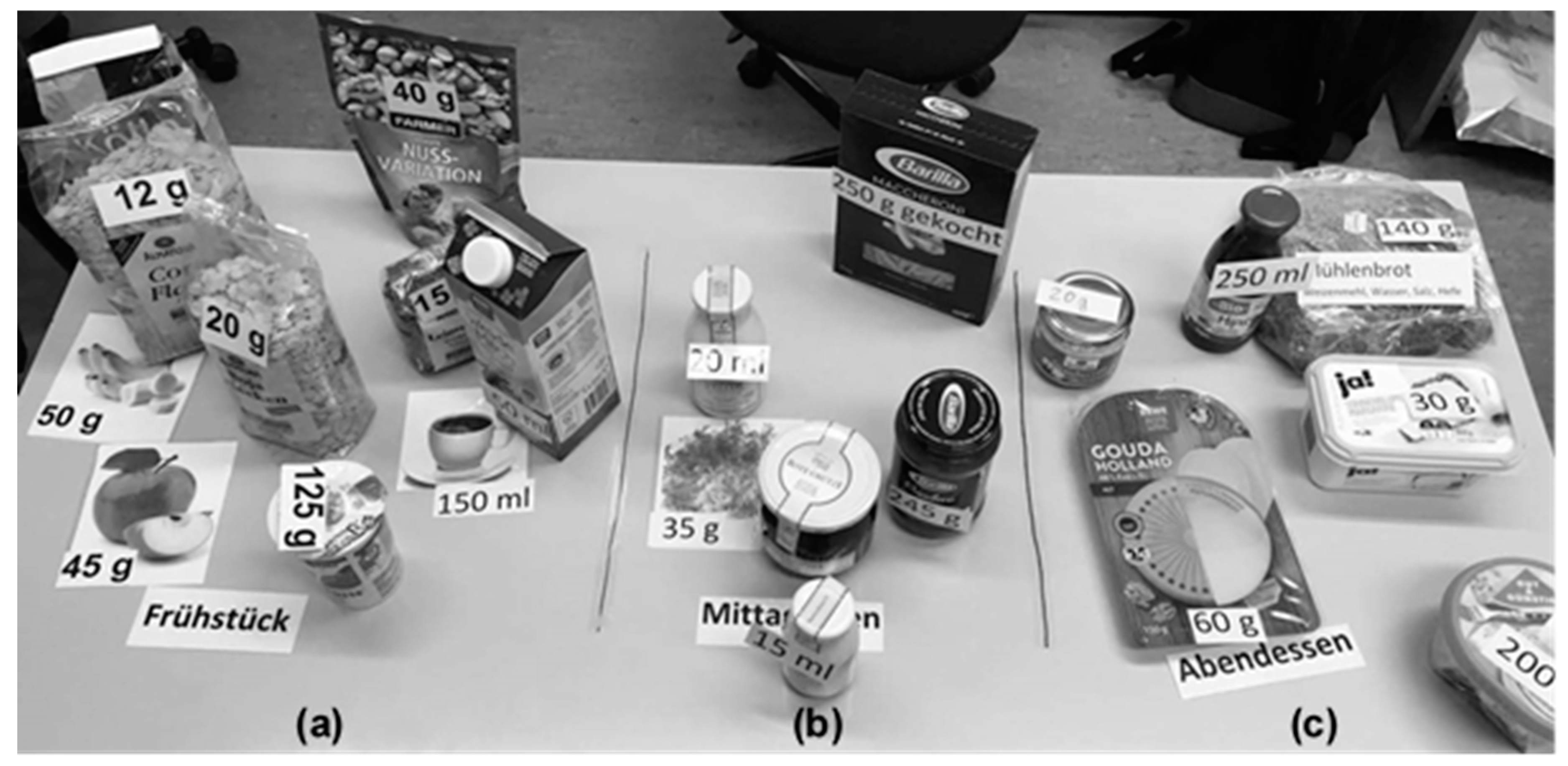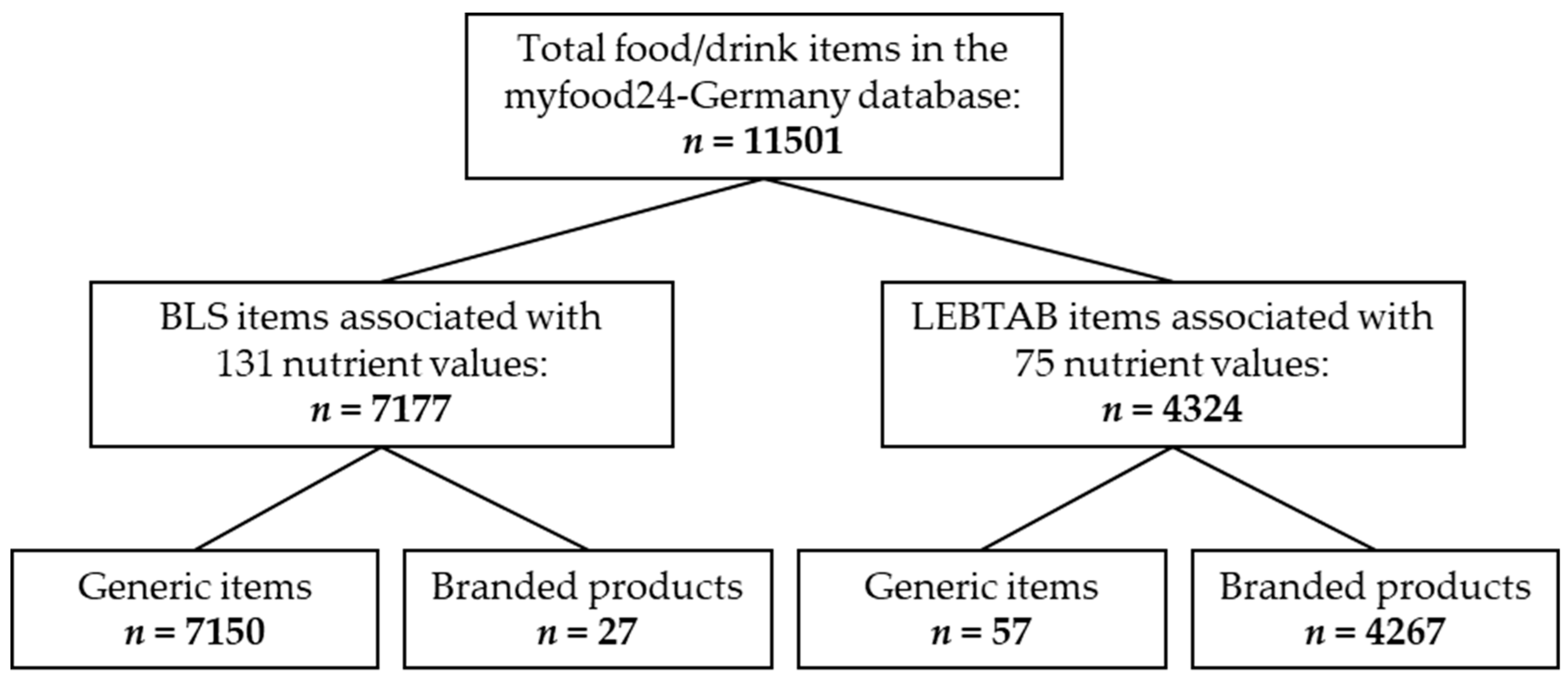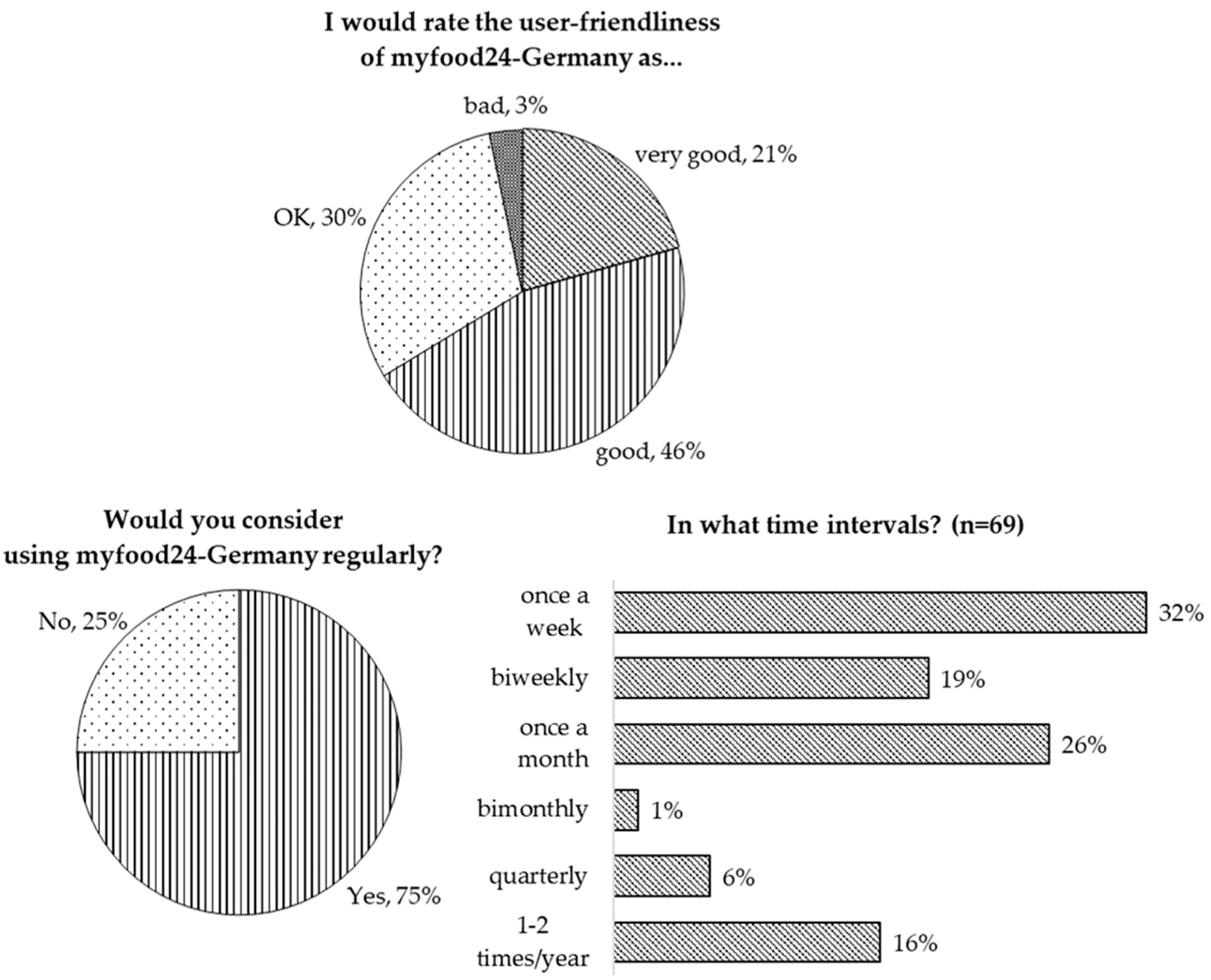Adaptation and Evaluation of Myfood24-Germany: A Web-Based Self-Administered 24-h Dietary Recall for the German Adult Population
Abstract
1. Introduction
2. Materials and Methods
2.1. Adapting myfood24 for Use in Germany
2.2. Evaluation of myfood24-Germany (Study 1)
2.2.1. Recruitment and Study Design
2.2.2. Assessment of Usability and Acceptability of myfood24-Germany
2.2.3. Assessment of Further Covariates
2.2.4. Statistical Analyses
2.3. Evaluation of Participants’ Individual Search Strategy (Study 2)
2.3.1. Recruitment and Study Design
2.3.2. Statistical Analyses
3. Results
3.1. myfood24-Germany
3.2. Evaluation of myfood24-Germany (Study 1)
3.3. Evaluation of Participants’ Individual Search Strategy (Study 2)
3.3.1. Analyses of Individual Search Strategies (Analysis 1)
3.3.2. Comparison of Energy and Nutrient Intakes (Analysis 2)
4. Discussion
5. Conclusions
Supplementary Materials
Author Contributions
Funding
Acknowledgments
Conflicts of Interest
References
- Carroll, R.J.; Midthune, D.; Subar, A.F.; Shumakovich, M.; Freedman, L.S.; Thompson, F.E.; Kipnis, V. Taking advantage of the strengths of 2 different dietary assessment instruments to improve intake estimates for nutritional epidemiology. Am. J. Epidemiol. 2012, 175, 340–347. [Google Scholar] [CrossRef] [PubMed]
- Conrad, J.; Nöthlings, U. Innovative approaches to estimate individual usual dietary intake in large-scale epidemiological studies. Proc. Nutr. Soc. 2017, 76, 213–219. [Google Scholar] [CrossRef] [PubMed]
- Brassard, D.; Fulgoni, V.L.; Robitaille, J.; Lemieux, S.; Lamarche, B. Examining the Advantages of Using Multiple Web-Based Dietary Assessment Instruments to Measure Population Dietary Intake: The PREDISE Study. Curr. Dev. Nutr. 2019, 3, nzz014. [Google Scholar] [CrossRef] [PubMed]
- Park, Y.; Dodd, K.W.; Kipnis, V.; Thompson, F.E.; Potischman, N.; Schoeller, D.A.; Baer, D.J.; Midthune, D.; Troiano, R.P.; Bowles, H.; et al. Comparison of self-reported dietary intakes from the Automated Self-Administered 24-h recall, 4-d food records, and food-frequency questionnaires against recovery biomarkers. Am. J. Clin. Nutr. 2018, 107, 80–93. [Google Scholar] [CrossRef] [PubMed]
- Conrad, J.; Koch, S.A.J.; Nöthlings, U. New approaches in assessing food intake in epidemiology. Curr. Opin. Clin. Nutr. Metab. Care 2018, 21, 343–351. [Google Scholar] [CrossRef]
- Carter, M.C.; Hancock, N.; Albar, S.A.; Brown, H.; Greenwood, D.C.; Hardie, L.J.; Frost, G.S.; Wark, P.A.; Cade, J.E. Development of a New Branded UK Food Composition Database for an Online Dietary Assessment Tool. Nutrients 2016, 8, 480. [Google Scholar] [CrossRef]
- Carter, M.C.; Albar, S.A.; Morris, M.A.; Mulla, U.Z.; Hancock, N.; Evans, C.E.; Alwan, N.A.; Greenwood, D.C.; Hardie, L.J.; Frost, G.S.; et al. Development of a UK Online 24-h Dietary Assessment Tool: Myfood24. Nutrients 2015, 7, 4016–4032. [Google Scholar] [CrossRef]
- Albar, S.A.; Carter, M.C.; Alwan, N.A.; Evans, C.E.L.; Cade, J.E. Formative evaluation of the usability and acceptability of myfood24 among adolescents: A UK online dietary assessments tool. BMC Nutr. 2015, 1, 29. [Google Scholar] [CrossRef]
- Albar, S.A.; Alwan, N.A.; Evans, C.E.L.; Greenwood, D.C.; Cade, J.E. Agreement between an online dietary assessment tool (myfood24) and an interviewer-administered 24-h dietary recall in British adolescents aged 11–18 years. Br. J. Nutr. 2016, 115, 1678–1686. [Google Scholar] [CrossRef]
- Wark, P.A.; Hardie, L.J.; Frost, G.S.; Alwan, N.A.; Carter, M.; Elliott, P.; Ford, H.E.; Hancock, N.; Morris, M.A.; Mulla, U.Z.; et al. Validity of an online 24-h recall tool (myfood24) for dietary assessment in population studies: Comparison with biomarkers and standard interviews. BMC Med. 2018, 16, 136. [Google Scholar] [CrossRef]
- Moshfegh, A.J.; Rhodes, D.G.; Baer, D.J.; Murayi, T.; Clemens, J.C.; Rumpler, W.V.; Paul, D.R.; Sebastian, R.S.; Kuczynski, K.J.; Ingwersen, L.A.; et al. The US Department of Agriculture Automated Multiple-Pass Method reduces bias in the collection of energy intakes. Am. J. Clin. Nutr. 2008, 88, 324–332. [Google Scholar] [CrossRef]
- Hartmann, B.M.; Vásquez-Caicedo, A.L.; Bell, S.; Krems, C.; Brombach, C. The German nutrient database: Basis for analysis of the nutritional status of the German population. J. Food Compos. Anal. 2008, 21, S115–S118. [Google Scholar] [CrossRef]
- Buyken, A.E.; Alexy, U.; Kersting, M.; Remer, T. Die DONALD Kohorte. Ein aktueller Überblick zu 25 Jahren Forschung im Rahmen der Dortmund Nutritional and Anthropometric Longitudinally Designed Study. Bundesgesundheitsblatt Gesundheitsforschung Gesundheitsschutz 2012, 55, 875–884. [Google Scholar] [CrossRef] [PubMed]
- Sichert-Hellert, W.; Kersting, M.; Chahda, C.; Schäfer, R.; Kroke, A. German food composition database for dietary evaluations in children and adolescents. J. Food Compos. Anal. 2007, 20, 63–70. [Google Scholar] [CrossRef]
- Dehne, L.I.; Klemm, C.; Henseler, G.; Hermann-Kunz, E. The German Food Code and Nutrient Data Base (BLS II.2). Eur. J. Epidemiol. 1999, 15, 355–359. [Google Scholar] [CrossRef]
- Eisinger-Watzl, M.; Straßburg, A.; Ramünke, J.; Krems, C.; Heuer, T.; Hoffmann, I. Comparison of two dietary assessment methods by food consumption: Results of the German National Nutrition Survey II. Eur. J. Nutr. 2015, 54, 343–354. [Google Scholar] [CrossRef]
- Kroke, A.; Manz, F.; Kersting, M.; Remer, T.; Sichert-Hellert, W.; Alexy, U.; Lentze, M.J. The DONALD Study. History, current status and future perspectives. Eur. J. Nutr. 2004, 43, 45–54. [Google Scholar] [CrossRef]
- Wahrburg, U.; Egert, S. Die große Wahrburg/Egert Kalorien- & Nährwerttabelle: Erstmals auf einen Blick: Mit den Nährwerten pro Portion & pro 100 g, 4th ed.; TRIAS: Stuttgart, Germany, 2015. [Google Scholar]
- Dinauer, M.; Winkler, A.; Winkler, G. Monica-Mengenliste; Aid Infodienst Ernährung, Landwirtschaft, Verbraucherschutz e.V.: Bonn, Germany, 1991. [Google Scholar]
- Nestlé Deutschland, A.G. (Ed.) Kalorien Mundgerecht: Das praxisorientierte Handbuch für das tägliche Essen und Trinken; mit Angaben zu Energie, Eiweiß, Kohlenhydraten, Zucker, Ballaststoffen, Fett, Gesättigten Fettsäuren, Natrium und Broteinheiten, Bezogen auf übliche Portionen, 14th ed.; Neuer Umschau-Buchverlag: Neustadt an der Weinstraße, Germany, 2010. [Google Scholar]
- Foster, E.; Hawkins, A.; Barton, K.L.; Stamp, E.; Matthews, J.N.S.; Adamson, A.J. Development of food photographs for use with children aged 18 months to 16 years: Comparison against weighed food diaries—The Young Person’s Food Atlas (UK). PLoS ONE 2017, 12, e0169084. [Google Scholar] [CrossRef]
- Brooke, J. SUS-A Quick and Dirty Usability Scale. 1996. Available online: https://hell.meiert.org/core/pdf/sus.pdf (accessed on 8 January 2018).
- Brooke, J. SUS: A Retrospective. J. Usability Stud. 2013, 8, 29–40. [Google Scholar]
- Bangor, A.; Kortum, P.T.; Miller, J.T. An Empirical Evaluation of the System Usability Scale. Int. J. Human-Computer Interact. 2008, 24, 574–594. [Google Scholar] [CrossRef]
- Bangor, A.; Kortum, P.; Miller, J. Determining What Individual SUS Scores Mean: Adding an Adjective Rating Scale. J. Usability Stud. 2009, 4, 114–123. [Google Scholar]
- SAP User Experience Community. System Usability Scale—Jetzt Auch Auf Deutsch. 2015. Available online: https://experience.sap.com/skillup/system-usability-scale-jetzt-auch-auf-deutsch/ (accessed on 6 November 2018).
- Apowersoft Ltd. Free Online Screen Recorder. Available online: https://www.apowersoft.com/free-online-screen-recorder (accessed on 8 October 2019).
- Simpson, E.; Bradley, J.; Poliakov, I.; Jackson, D.; Olivier, P.; Adamson, A.J.; Foster, E. Iterative Development of an Online Dietary Recall Tool: INTAKE24. Nutrients 2017, 9, 118. [Google Scholar] [CrossRef] [PubMed]
- Ettienne-Gittens, R.; Boushey, C.J.; Au, D.; Murphy, S.P.; Lim, U.; Wilkens, L. Evaluating the feasibility of utilizing the Automated Self-administered 24-hour (ASA24) dietary recall in a sample of multiethnic older adults. Procedia Food Sci. 2013, 2, 134–144. [Google Scholar] [CrossRef] [PubMed]
- Gilsing, A.; Mayhew, A.J.; Payette, H.; Shatenstein, B.; Kirkpatrick, S.I.; Amog, K.; Wolfson, C.; Kirkland, S.; Griffith, L.E.; Raina, P. Validity and Reliability of a Short Diet Questionnaire to Estimate Dietary Intake in Older Adults in a Subsample of the Canadian Longitudinal Study on Aging. Nutrients 2018, 10, 1522. [Google Scholar] [CrossRef]
- Rowland, M.K.; Adamson, A.J.; Poliakov, I.; Bradley, J.; Simpson, E.; Olivier, P.; Foster, E. Field Testing of the Use of Intake24-An Online 24-Hour Dietary Recall System. Nutrients 2018, 10, 1690. [Google Scholar] [CrossRef]
- Ward, H.A.; McLellan, H.; Udeh-Momoh, C.; Giannakopoulou, P.; Robb, C.; Wark, P.A.; Middleton, L. Use of Online Dietary Recalls among Older UK Adults: A Feasibility Study of an Online Dietary Assessment Tool. Nutrients 2019, 11, 1451. [Google Scholar] [CrossRef]
- Eldridge, A.L.; Piernas, C.; Illner, A.-K.; Gibney, M.J.; Gurinović, M.A.; de Vries, J.H.M.; Cade, J.E. Evaluation of New Technology-Based Tools for Dietary Intake Assessment-An ILSI Europe Dietary Intake and Exposure Task Force Evaluation. Nutrients 2018, 11, 55. [Google Scholar] [CrossRef]
- Kirkpatrick, S.I.; Gilsing, A.M.; Hobin, E.; Solbak, N.M.; Wallace, A.; Haines, J.; Mayhew, A.J.; Orr, S.K.; Raina, P.; Robson, P.J.; et al. Lessons from Studies to Evaluate an Online 24-Hour Recall for Use with Children and Adults in Canada. Nutrients 2017, 9, 100. [Google Scholar] [CrossRef]
- National Cancer Institute. ASA24 Automated Self-Administered 24-Hour Dietary Assessment Tool, System Requirements and Accessibility. 2018. Available online: https://epi.grants.cancer.gov/asa24/respondent/system-requirements.html (accessed on 5 June 2019).
- Kupis, J.; Johnson, S.; Hallihan, G.; Olstad, D.L. Assessing the Usability of the Automated Self-Administered Dietary Assessment Tool (ASA24) among Low-Income Adults. Nutrients 2019, 11, 132. [Google Scholar] [CrossRef]
- Evans, K.; Hennessy, Á.; Walton, J.; Timon, C.; Gibney, E.; Flynn, A. Development and evaluation of a concise food list for use in a web-based 24-h dietary recall tool. J. Nutr. Sci. 2017, 6, e46. [Google Scholar] [CrossRef]
- Chen, J.; Berkman, W.; Bardouh, M.; Ng, C.Y.K.; Allman-Farinelli, M. The use of a food logging app in the naturalistic setting fails to provide accurate measurements of nutrients and poses usability challenges. Nutrition (Burbank, Los Angeles County, Calif.) 2019, 57, 208–216. [Google Scholar] [CrossRef] [PubMed]
- Kirkpatrick, S.I.; Subar, A.F.; Douglass, D.; Zimmerman, T.P.; Thompson, F.E.; Kahle, L.L.; George, S.M.; Dodd, K.W.; Potischman, N. Performance of the Automated Self-Administered 24-hour Recall relative to a measure of true intakes and to an interviewer-administered 24-h recall. Am. J. Clin. Nutr. 2014, 100, 233–240. [Google Scholar] [CrossRef] [PubMed]
- Nielsen, J.; Landauer, T.K. A mathematical model of the finding of usability problems. In CHI ‘93: Proceedings of the INTERACT ‘93 and CHI ‘93 Conference on Human Factors in Computing Systems; Arnold, B., Ashlund, S., Eds.; ACM: Amsterdam, The Netherlands, 1993; pp. 206–213. [Google Scholar]



| Male Median (Q1–Q3) | Female Median (Q1–Q3) | |
|---|---|---|
| Participants, n (%) | 22 (24) | 70 (76) |
| Age, years | 27.5 (24.0–54.0) | 50.0 (25.0–62.0) |
| BMI, kg/m2 | 23.1(20.8–24.4) | 21.8 (19.6–23.7) |
| Smoker, n (%) | 2 (9.1) | 6 (8.6) |
| Education level, n (%) | ||
| No school-leaving qualification | - | 1 (1.4) |
| Trainee/Student | 5 (22.7) | 8 (11.4) |
| Vocational education | 2 (9.1) | 22 (31.4) |
| College/University degree | 15 (68.2) | 39 (55.7) |
| Type of diet, n (%) | ||
| Omnivores | 20 (90.9) | 57 (81.4) |
| Vegetarians | 1 (4.6) | 9 (12.9) |
| Vegans | 1 (4.6) | 4 (5.7) |
| Nutrition professionals, n (%) | 2 (9.1) | 17 (24.3) |
| Conducted a 24HDR before, n (%) | - | 10 (14.3) |
| Experience in using a computer/tablet, n (%) | 19 (86.4) | 52 (74.3) |
| Total Sample (17–78 Years) | Young Adults (≤30 Years) | Adults (31–65 Years) | Older Adults (>65 Years) | |
|---|---|---|---|---|
| Participants, n (%) | 92 | 46 (50) | 32 (35) | 14 (15) |
| Number of 24HDRs a | 367 | 183 | 128 | 56 |
| Female sex, % | 76 | 65 | 91 | 79 |
| SUS score, median (Q1–Q3) | 78 (66–84) | 78 (65–85) | 78 (66–85) | 74 (70–83) |
| Completion time in minutes, median (Q1–Q3) | 15 (9–23) | 11 (7–16) | 19 (13–28) | 23 (16–32) |
| Feature in Myfood24 | Used by n (%) of Participants | Considered Helpful by n (%) of Users |
|---|---|---|
| Optional quick list | 35 (38) | 31 (89) |
| Recipe builder | 33 (36) | 27 (82) |
| List of recently used items | 9 (10) | 8 (89) |
| Help function | 6 (7) | 5 (83) |
| Search filters | 47 (51) | 39 (83) |
| Total | Analysis 1 | Analysis 2 | |
|---|---|---|---|
| Participants, n (% female) | 15 (33) | 14 (36) | 9 (44) |
| Age, years a | 25 (21–39) | 25 (21–32) | 25 (21–32) |
| Educational status, n (%) | |||
| High school graduation | 3 (20) | 3 (21) | 2 (22) |
| Vocational education | 3 (20) | 3 (21) | 2 (22) |
| College/university degree | 9 (60) | 8 (58) | 5 (56) |
| Nutrient | Sample Meal | Reference Values a | Difference b | |
|---|---|---|---|---|
| Mean | SD | Total (%) | ||
| Energy, kcal | 2970 | 225 | 2928 | 42 (1.4) |
| Protein, g | 83 | 4 | 81 | 2 (2.5) |
| Fat, g | 135 | 16 | 131 | 4 (3.1) |
| Carbohydrates, g | 345 | 22 | 316 | 29 (9.2) |
© 2020 by the authors. Licensee MDPI, Basel, Switzerland. This article is an open access article distributed under the terms and conditions of the Creative Commons Attribution (CC BY) license (http://creativecommons.org/licenses/by/4.0/).
Share and Cite
Koch, S.A.J.; Conrad, J.; Hierath, L.; Hancock, N.; Beer, S.; Cade, J.E.; Nöthlings, U. Adaptation and Evaluation of Myfood24-Germany: A Web-Based Self-Administered 24-h Dietary Recall for the German Adult Population. Nutrients 2020, 12, 160. https://doi.org/10.3390/nu12010160
Koch SAJ, Conrad J, Hierath L, Hancock N, Beer S, Cade JE, Nöthlings U. Adaptation and Evaluation of Myfood24-Germany: A Web-Based Self-Administered 24-h Dietary Recall for the German Adult Population. Nutrients. 2020; 12(1):160. https://doi.org/10.3390/nu12010160
Chicago/Turabian StyleKoch, Stefanie A. J., Johanna Conrad, Linda Hierath, Neil Hancock, Sarah Beer, Janet E. Cade, and Ute Nöthlings. 2020. "Adaptation and Evaluation of Myfood24-Germany: A Web-Based Self-Administered 24-h Dietary Recall for the German Adult Population" Nutrients 12, no. 1: 160. https://doi.org/10.3390/nu12010160
APA StyleKoch, S. A. J., Conrad, J., Hierath, L., Hancock, N., Beer, S., Cade, J. E., & Nöthlings, U. (2020). Adaptation and Evaluation of Myfood24-Germany: A Web-Based Self-Administered 24-h Dietary Recall for the German Adult Population. Nutrients, 12(1), 160. https://doi.org/10.3390/nu12010160





